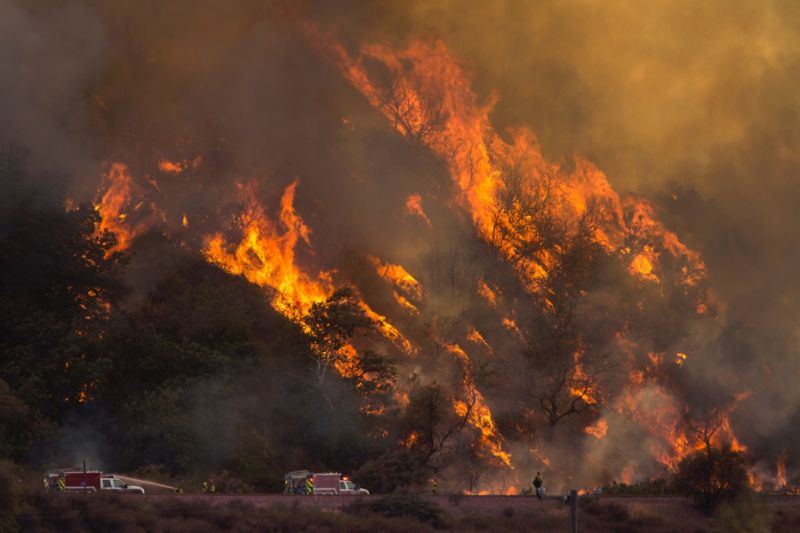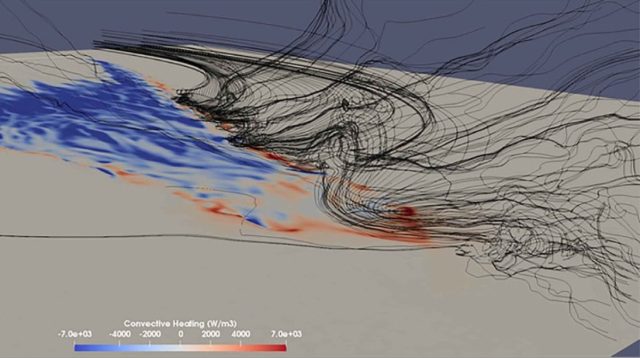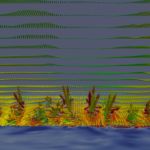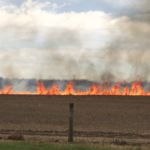Interaction between rising air, ambient winds determines how quickly a fire spreads.
JENNIFER OUELLETTE - 12/28/2019 arstechnica.com

Flames spread up a hillside near firefighters at the Blue
Cut Fire on August 18, 2016 near Wrightwood, California.
David McNew/Getty Images
There's rarely time to write about every cool science-y story that comes our way. So this year, we're once again running a special Twelve Days of Christmas series of posts, highlighting one science story that fell through the cracks each day, from December 25 through January 5. Today: How scientists at Los Alamos National Laboratory are modeling the complicated dynamic feedback loop between wildfires and the atmosphere to help prevent and control the spread of devastating wildfires in the future.
From a physics and chemistry standpoint, fire is an incredibly complicated phenomenon—so much so that 19th century physicist Michael Faraday built an entire series of six lectures around the flame of a single candle at the Royal Institution in 1848. Fuel, heat, and oxygen, combined under the right conditions, ignite into a sustained chemical reaction: fire. Add in factors like conduction, convection, radiation, and any number of environmental factors, and that fire can rapidly spread out of control.
Scientists have been trying to better delineate how wildfires spread for decades, and understanding the complicated fluid dynamics at work is key to those efforts. Rodman Linn, an atmospheric scientist at Los Alamos National Laboratory, does computational modeling of how fires interact with the surrounding atmosphere to predict how a given fire behaves. It's a challenging phenomenon to model, since it involves the interaction of several different processes. Linn describes the various factors that influence how a wildfire spreads in an article in the November issue of Physics Today.
Most models currently in use are based on seminal work done back in 1972 by Richard Rothermel, an aeronautical engineer who developed the first quantitative tool for predicting the spread of wildfires. Every kind of fuel has an ignition point (also known as a flash point), a measure of how much energy is required to ignite that fuel. Rothermel's model determined that ignition point and then factored in wind speed, the slope of the ground, and other critical factors to calculate the rate of ignition required for a nascent wildfire to spread quickly.
Enlarge / Computer simulation showing stream traces
David McNew/Getty Images
There's rarely time to write about every cool science-y story that comes our way. So this year, we're once again running a special Twelve Days of Christmas series of posts, highlighting one science story that fell through the cracks each day, from December 25 through January 5. Today: How scientists at Los Alamos National Laboratory are modeling the complicated dynamic feedback loop between wildfires and the atmosphere to help prevent and control the spread of devastating wildfires in the future.
From a physics and chemistry standpoint, fire is an incredibly complicated phenomenon—so much so that 19th century physicist Michael Faraday built an entire series of six lectures around the flame of a single candle at the Royal Institution in 1848. Fuel, heat, and oxygen, combined under the right conditions, ignite into a sustained chemical reaction: fire. Add in factors like conduction, convection, radiation, and any number of environmental factors, and that fire can rapidly spread out of control.
Scientists have been trying to better delineate how wildfires spread for decades, and understanding the complicated fluid dynamics at work is key to those efforts. Rodman Linn, an atmospheric scientist at Los Alamos National Laboratory, does computational modeling of how fires interact with the surrounding atmosphere to predict how a given fire behaves. It's a challenging phenomenon to model, since it involves the interaction of several different processes. Linn describes the various factors that influence how a wildfire spreads in an article in the November issue of Physics Today.
Most models currently in use are based on seminal work done back in 1972 by Richard Rothermel, an aeronautical engineer who developed the first quantitative tool for predicting the spread of wildfires. Every kind of fuel has an ignition point (also known as a flash point), a measure of how much energy is required to ignite that fuel. Rothermel's model determined that ignition point and then factored in wind speed, the slope of the ground, and other critical factors to calculate the rate of ignition required for a nascent wildfire to spread quickly.

Enlarge / Computer simulation showing stream traces
of winds reaching the left flank and head of a fire spreading
up a steep slope.
Alexandra Jonko/Los Alamos National Laboratory
But it's a simplified model, akin to a fire spreading through a uniform field, whereas wildfires tend to spread through landscapes dotted with trees, shrubs, underbrush, and so forth. When the situation starts to deviate strongly from the basic underlying fire scenario—a wind-driven fire and homogenous fuels on a homogenous slope—the so-called BEHAVE model becomes less accurate. "The minute you get something that's complex in terms of fuel structure, or the topography—or even worse if you have multiple fire lines—you're adding complexity to the coupling between the fire and the atmosphere that was not present in the development of those early models," Linn told Ars.
That's why Linn's research focuses on the dynamic feedback loop between the fire and its interaction with the atmosphere, especially winds. "The interaction between rising air and ambient winds controls the rate at which surrounding vegetation heats up and whether it ignites," he wrote. "The interaction thus determines how quickly a fire spreads."
According to Lin, something you won't see in a more accurate model of a wildfire is a solid advancing wall of flame. "Convective cooling would prevent the wall of flame from spreading by radiation alone, and for convective heating to spread the fire, the wind would have to be strong enough to lean the flame to the point where it touches the unburned fuel," he wrote. A more accurate depiction of what a wildfire looks like from the front would show several strong updrafts, creating towers of flame separated by gaps or troughs. The updrafts carry heat up, and ambient wind is pushed through the troughs, heating up as it travels and possibly igniting any available fuel in front of the fire.
The shape of the fireline can also influence how a fire spreads. There may be flanking fires trailing behind the fast-moving headfire, according to Linn, forming a horseshoe shape, which can determine how much wind reaches the headfire. If the horseshoe of flanking fires is narrow, more wind will be diverted to the flanks and the wind that actually reaches the headfire will be moving more slowly, resulting in a slower spread rate.

A computer-generated snapshot of a grass fire showing updraft towers and troughs, with wind-speed vectors. R. Linn/Los Alamos National Laboratory

An experimental grass fire shows what the towers and troughs look like in reality.
Mark Finney/US Forest Service, Missoula Fire Sciences Laboratory
One common means of preventing the outbreak of devastating wildfires is prescribed burns, which can restore some balance to the ecosystem. Historically, fires have proven beneficial in terms of clearing out brush and other excessive fuels. But to perform prescribed burns effectively requires factoring in variable winds, the unique terrain, and vegetation patterns. "When firefighters place a new fire line downwind of a fire, they often hope that the indrafts will pull the so-called 'counter fire' toward the wildfire and remove fuel in front of it," Linn wrote. "Unfortunately, the maneuver requires a good understanding of the wildfire's indraft strength. Too weak an indraft could turn the counter fire into a second wildfire."
There are regional differences, too. The way firefighters in the Southeast set prescribed burns might not work well in California. "The fuels are a little bit different, the topography can be more extreme," Linn told Ars. "The humidity can be different." And that requires a different approach to prescribed burns.
Linn and his LANL colleagues have drawn on the lessons they've learned to develop new computer programs for simulating the spread of wildfires, with an aim toward achieving better prevention and more effective firefighting strategies. For instance, FIRETEC specifically models a fire's interactions with the atmosphere. The user just needs to feed in information about the landscape, ignition pattern, and ambient wind conditions, and the program will calculate how the fire is likely to evolve and spread through that landscape.
Linn et al. are now developing another software program called QUIC-FIRE, which will be able to operate on a laptop. It will incorporate such variables as weather, terrain, fuels, aerodynamics, combustion, turbulence, and heat transfer to help firefighters devise the best strategies for implementing prescribed burns.
DOI: Physics Today, 2019. 10.1063/PT.3.4350 (About DOIs).
Courtesy of Los Alamos National Laboratory.
Alexandra Jonko/Los Alamos National Laboratory
But it's a simplified model, akin to a fire spreading through a uniform field, whereas wildfires tend to spread through landscapes dotted with trees, shrubs, underbrush, and so forth. When the situation starts to deviate strongly from the basic underlying fire scenario—a wind-driven fire and homogenous fuels on a homogenous slope—the so-called BEHAVE model becomes less accurate. "The minute you get something that's complex in terms of fuel structure, or the topography—or even worse if you have multiple fire lines—you're adding complexity to the coupling between the fire and the atmosphere that was not present in the development of those early models," Linn told Ars.
That's why Linn's research focuses on the dynamic feedback loop between the fire and its interaction with the atmosphere, especially winds. "The interaction between rising air and ambient winds controls the rate at which surrounding vegetation heats up and whether it ignites," he wrote. "The interaction thus determines how quickly a fire spreads."
According to Lin, something you won't see in a more accurate model of a wildfire is a solid advancing wall of flame. "Convective cooling would prevent the wall of flame from spreading by radiation alone, and for convective heating to spread the fire, the wind would have to be strong enough to lean the flame to the point where it touches the unburned fuel," he wrote. A more accurate depiction of what a wildfire looks like from the front would show several strong updrafts, creating towers of flame separated by gaps or troughs. The updrafts carry heat up, and ambient wind is pushed through the troughs, heating up as it travels and possibly igniting any available fuel in front of the fire.
The shape of the fireline can also influence how a fire spreads. There may be flanking fires trailing behind the fast-moving headfire, according to Linn, forming a horseshoe shape, which can determine how much wind reaches the headfire. If the horseshoe of flanking fires is narrow, more wind will be diverted to the flanks and the wind that actually reaches the headfire will be moving more slowly, resulting in a slower spread rate.

A computer-generated snapshot of a grass fire showing updraft towers and troughs, with wind-speed vectors. R. Linn/Los Alamos National Laboratory

An experimental grass fire shows what the towers and troughs look like in reality.
Mark Finney/US Forest Service, Missoula Fire Sciences Laboratory
One common means of preventing the outbreak of devastating wildfires is prescribed burns, which can restore some balance to the ecosystem. Historically, fires have proven beneficial in terms of clearing out brush and other excessive fuels. But to perform prescribed burns effectively requires factoring in variable winds, the unique terrain, and vegetation patterns. "When firefighters place a new fire line downwind of a fire, they often hope that the indrafts will pull the so-called 'counter fire' toward the wildfire and remove fuel in front of it," Linn wrote. "Unfortunately, the maneuver requires a good understanding of the wildfire's indraft strength. Too weak an indraft could turn the counter fire into a second wildfire."
There are regional differences, too. The way firefighters in the Southeast set prescribed burns might not work well in California. "The fuels are a little bit different, the topography can be more extreme," Linn told Ars. "The humidity can be different." And that requires a different approach to prescribed burns.
Linn and his LANL colleagues have drawn on the lessons they've learned to develop new computer programs for simulating the spread of wildfires, with an aim toward achieving better prevention and more effective firefighting strategies. For instance, FIRETEC specifically models a fire's interactions with the atmosphere. The user just needs to feed in information about the landscape, ignition pattern, and ambient wind conditions, and the program will calculate how the fire is likely to evolve and spread through that landscape.
Linn et al. are now developing another software program called QUIC-FIRE, which will be able to operate on a laptop. It will incorporate such variables as weather, terrain, fuels, aerodynamics, combustion, turbulence, and heat transfer to help firefighters devise the best strategies for implementing prescribed burns.
DOI: Physics Today, 2019. 10.1063/PT.3.4350 (About DOIs).
Courtesy of Los Alamos National Laboratory.
No comments:
Post a Comment